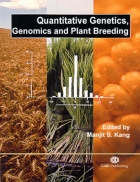




Mã tài liệu: 202398
Số trang: 417
Định dạng: pdf
Dung lượng file:
Chuyên mục: Khoa học công nghệ
A majority of economically important plant and animal traits, such as grain yield or meat production, can be classified as multigenic or quantitative. The application of statistical methods in the improvement of such traits – applied quantitative genetics – began early in the 20th century, when many researchers questioned whether the inheritance of these continuously distributed traits was Mendelian. During the past century, however, both plant and animal geneticists have obtained convincing evidence that Mendelian principles apply to quantitative as well as qualitative traits. This evidence has also shaped the general model that embraces the multiple-factor hypothesis for quantitative traits (with genes located in chromosomes and hence sometimes linked, and incomplete heritability because of the contribution of environmental factors to total phenotypic variation). The early efforts by outstanding scientists, such as R.A. Fisher, G.W. Snedecor and J.L. Lush, have been followed over the decades with many avenues of research in both the applied and theoretical aspects of quantitative genetics. More recently, the linking of molecular genetics and genomics with the study, evaluation and improvement of quantitative traits has become the central theme of much exciting research. The recent developments in the areas of quantitative trait locus mapping, bioinformatics, marker-assisted selection and molecular-enhanced breeding strategies have just scratched the surface in the molecular dissection of complexly inherited traits. DNA-based technologies will provide a complete new kit of tools for plant and animal breeders for the improvement of quantitative traits. Genotype–environment interaction will continue to be a major factor as researchers focus on the improvement as well as the stability of such traits.
This book will serve as a valuable research and teaching reference. The collection of papers will provide knowledge from which to launch new research efforts on the nature of the inheritance of quantitative traits as well as the development of new technologies for improving such traits. Hopefully, it will stimulate expanded efforts to exploit the full potential of genomics, bioinformatics and molecular-enhanced breeding technologies in the study and utilization of quantitative variation in plant and animal species. The efforts of Dr Manjit Kang in organizing the symposium on ‘Quantitative Genetics and Plant Breeding in the 21st Century’ and the editing of the proceedings are commendable. He has assembled papers for a truly exceptional volume that will serve as an important reference for quantitative geneticists and plant and animal breeders for many years into the future.
Những tài liệu gần giống với tài liệu bạn đang xem
📎 Số trang: 283
👁 Lượt xem: 324
⬇ Lượt tải: 16
📎 Số trang: 468
👁 Lượt xem: 275
⬇ Lượt tải: 16
Những tài liệu bạn đã xem
 Quantitative Genetics
A majority of economically important plant and animal traits, such as grain yield or meat production, can be classified as multigenic or quantitative. The application of statistical methods in the improvement of such traits – applied quantitative
pdf Đăng bởi
huynhvantuan1967
Quantitative Genetics
A majority of economically important plant and animal traits, such as grain yield or meat production, can be classified as multigenic or quantitative. The application of statistical methods in the improvement of such traits – applied quantitative
pdf Đăng bởi
huynhvantuan1967